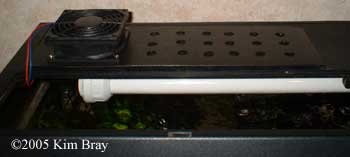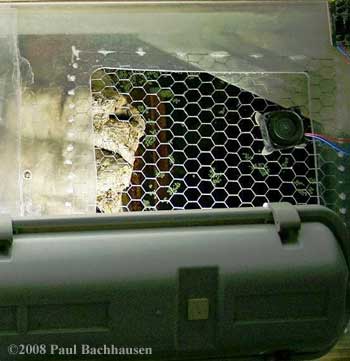Aquarium Cooling Methods
Compiled by Jennifer Macke
Why cool my aquarium?
- To make the captive environment more like nature. Most newts and salamanders in the wild live in much cooler temperatures than what an indoor environment provides.
- For optimal health. Temperatures closer to nature are likely to keep animals healthier longer.
- To provide a winter cooling period (some call it hibernation), which is necessary for breeding in many species.
- To avoid peak summer heat, which can be deadly to many newts, salamanders, and axolotls.
General Methods
- Air condition the room or the house. Window-mounted single-room air conditioning units can be obtained for a reasonable cost.
- Get an aquarium chiller. There are 2 basic types of chillers: refrigerated chillers, and thermoelectric (Peltier effect) chillers. Refrigerated chillers are very expensive, but also very effective. Thermoelectric chillers (for example, the Ice Probe) are less expensive but also much less effective. In a tank over 10 gallons in size, the Peltier cooler may be able to reduce temperature by only a few degrees, which is not much better than you can do with evaporation.
- Increase evaporation. The evaporation of water decreases the temperature of the remaining water. Using only evaporation, it is possible to get the tank temperature lower than the ambient room temperature. There are several specific ways that you can expoit evaporative cooling:
- Use a screen top instead of a hood. This alone will lower the temperature 2°F (1°C) or more (see Example 1 below).
- In conjuction with the screen lid, a small airstone or other bubbling device will increase evaporation. A filter that spills water across the surface will achieve the same purpose.
- Install a fan over the tank (see examples below).
- Put a wet towel on the outside of the tank glass and blow a fan against it.
- Move the tank. Put it in the basement or other cool area of the house. The floor of the room is usually several degrees cooler than the ceiling, so try putting the tank down on the floor. Move the tank out of any direct sunlight. Put the tank directly in front of the outflow from your AC system.
- Remove or reduce appliances. If you have an incandescent light, replace it with a fluorescent light - incandescent bulbs generate a lot of heat. If you have a fluorescent light, use it for fewer hours per day. Put a "spacer" to lift the fluorescent light up a little higher, away from the tank; the amount of light will be the same, but less heat will go into the tank.
- Use a bubble-driven filter instead of a powerhead or submersible filter. All motor-driven filters produce heat, often quite a lot of it. When choosing a filter, choose the one with the lowest wattage, as watts directly correlate with heat production.
- Bottles and jugs. Fill with water, put one in the freezer and one in the tank. Switch back and forth. Be sure to refill frequently with clean, dechlorinated water in case the bottle leaks.
- Ice cubes. Remove some water from the tank and replace it with ice cubes made with dechlorinated water. It is best to do this in the evening, to replicate the natural cycle of warm days and cool nights that the animal would have outdoors.
- Insulate the aquarium. Place sheets of styrofoam, or other insulating material, around the sides, back, and underside of the tank. If this is done in conjunction with other cooling methods it will make other cooling methods more effective. By itself, insulating the tank has no effect.
Example 1: Screen lid
The temperature readings shown below were taken in 2 nearly-identical aquariums that sit side-by-side on a table. Both tanks are the same size and have bubblers only (no motorized filter). Because of evaporation, the water temperature in the tank with a screen lid is more than 3°F cooler than the ambient air! The advantages of this method are that it requires no effort and poses no risk of malfunction.
Air temperature: 68.6°F (20.3°C)
Water temp (glass lid): 67.8°F (19.9°C)
Water temp (screen lid): 65.2°F (18.4°C)
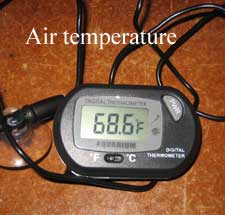
|
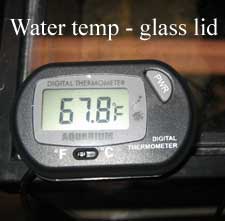
|
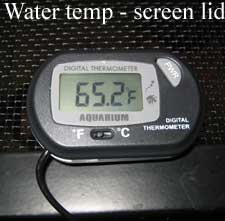
|
Example 2: Reef fan
Shops that sell products for saltwater reef tanks often sell clip-on fans like this one. They are made for use over aquariums. They come in a variety of sizes - for more examples, search online shops or eBay.
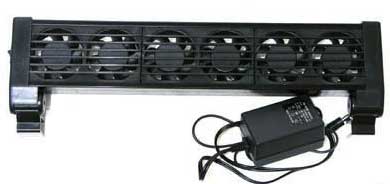
Example 3: Computer fans
In these examples, a small computer fan was mounted over an aquarium to increase evaporation. Note that computer fans need to be wired to a transformer in order to plug into a household electrical socket. (A how-to for wiring a computer fan to a household socket is shown in this forum thread.)
|
|
|
In the example below, 2 fans are used, with one blowing INWARD, the other blowing OUTWARD. The tank's owner was able to achieve a temperature drop of 6-8°F (3-4°C).
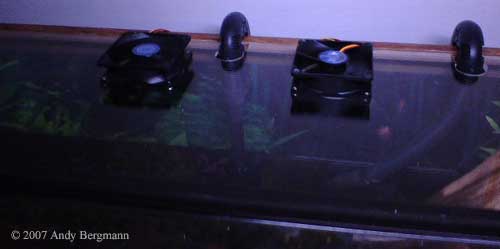
Example 4: Household fans
In this example, two small household fans are used to increase tank evaporation. Note that this only works if the tank has a screen lid, not a hood. Do not use this method for terrestrial tanks, or aquatic animals that spend much time out of the water, as the evaporation can dry out the amphibians.
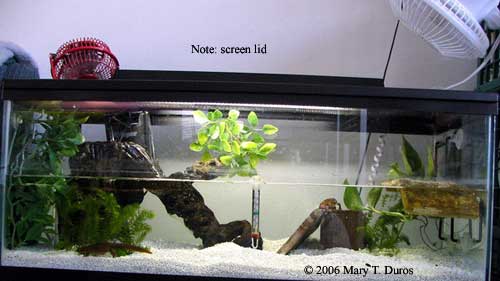
Example 5: Ice water
This is a more sophisticated homemade cooling device. A pump or canister filter pumps the water through tubing, which passes through a large cooler containing ice water. While this method can be very effective, the ice must be replenished at least once daily.
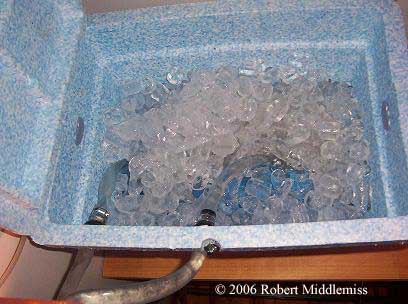
Example 6: Insulated "tank"
Description by Pin-pin Wei: "I used screen mesh because I had an aquatic set-up and because I was too lazy to cut glass - screen is cheap. The water (only 2-5 inches; 5-12 cm) stays a cool 60°F (15.5°C) if you add about 1 liter of refrigerated water (~50°F; 10°C) once a day. It's not as pretty as a glass tank with a cooling system, but it's a whole lot cheaper."
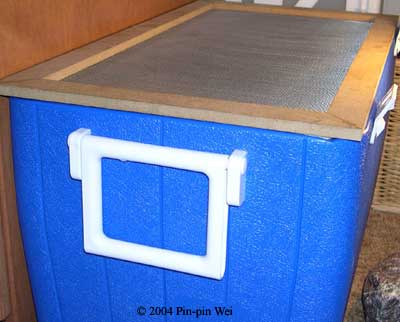
Example 7: Water cooler
A water cooler can be used to cool aquarium water. If an aquarium pump is used to push water directly into the water bottle, the flow rate is too fast and the bottle could overflow. Instead, the water from the pump goes into a reservoir inside the tank (excess water can simply overflow within the tank). The water from the reservoir moves by simple gravity (siphon flow) into the water bottle, and then back into the tank.
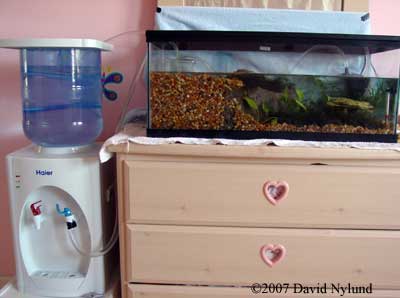
Example 8: Wine cooler
A wine cooler can be used to cool a terrarium. For construction details, see original forum post.
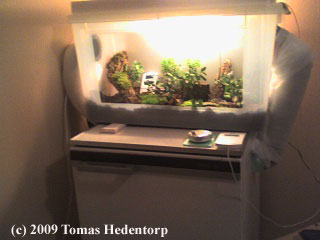
Example 9a: Cooler on terrarium
An ordinary cooler can be used to cool a terrarium. The components used here are: small cooler, PVC pipe, two computer fans, and ice or ice packs. For construction details, see original forum post.
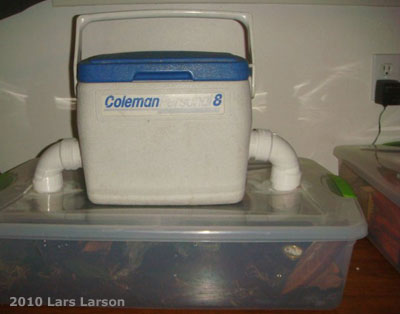
Example 9b: Cooler on terrarium (built-in cooling element)
This cooler has built-in electrical refrigeration. It can be used to cool a terrarium. For construction details, see original forum post.
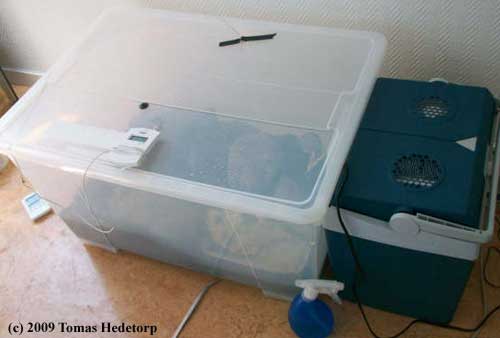
Example 10: Winter cooling with outdoor heat sink
Note: this is a WINTER cooling method, not for use during summer. Description by Jonathon: "Set up your container for tank water level with your tank and connect a tube between them to siphon water out of the aquarium. Put your pump in the container and attach a tube from the pump going out of the window. Run the tubing outside to the grill and weave it back and forth between the bars of the grill along its length, and then weave it back through the other direction; repeat this until you have it through the length of the grill a half a dozen times or so. Fill up your bucket/container of junk water and submerge the grill in the bottom. Add the other pieces of metal to the bucket and ensure that they are breaking the surface of the water. Run the rest of the tube back inside through the window and into your tank. This setup can be made more effective by increasing the size of the bucket and grill and the amount of water outside. Also there's no vibration because the pump is in a separate container from the aquarium. This setup can't be used to cool a tank when it's hot outside."
For more information, see original forum post.
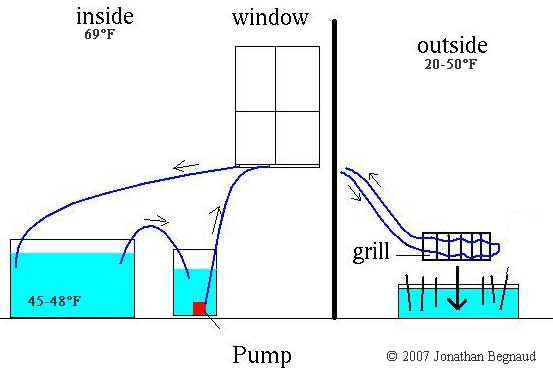
Example 11: Winter cooling
Another example of WINTER cooling. This tank was moved to the garage. With a submersible or canister filter, the tank will not freeze even if the air temperature dips briefly below freezing. However, there are some very cold climates where this would be too risky.
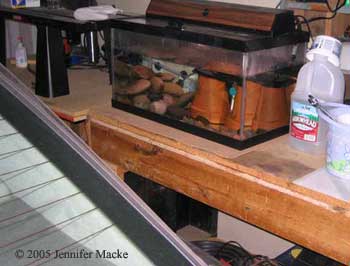
Example 12: DIY chiller from a mini-fridge
Related Links
Beat the Heat: Aquarium Cooling Methods an article at Reefkeeping
Chiller Info information about chillers compiled at The Krib

